Assessing the Severity of Health States Based on Social Media Posts
Shweta Yadav,
Joy Prakash Sain,
Amit Sheth,
Asif Ekbal,
Sriparna Saha,
Pushpak Bhattacharyya

Auto-TLDR; A Multiview Learning Framework for Assessment of Health State in Online Health Communities
Similar papers
Adversarial Training for Aspect-Based Sentiment Analysis with BERT
Akbar Karimi, Andrea Prati, Leonardo Rossi

Auto-TLDR; Adversarial Training of BERT for Aspect-Based Sentiment Analysis
Abstract Slides Poster Similar
Mood Detection Analyzing Lyrics and Audio Signal Based on Deep Learning Architectures
Konstantinos Pyrovolakis, Paraskevi Tzouveli, Giorgos Stamou

Auto-TLDR; Automated Music Mood Detection using Music Information Retrieval
Abstract Slides Poster Similar
Efficient Sentence Embedding Via Semantic Subspace Analysis
Bin Wang, Fenxiao Chen, Yun Cheng Wang, C.-C. Jay Kuo

Auto-TLDR; S3E: Semantic Subspace Sentence Embedding
Abstract Slides Poster Similar
KoreALBERT: Pretraining a Lite BERT Model for Korean Language Understanding
Hyunjae Lee, Jaewoong Yun, Bongkyu Hwang, Seongho Joe, Seungjai Min, Youngjune Gwon

Auto-TLDR; KoreALBERT: A monolingual ALBERT model for Korean language understanding
Abstract Slides Poster Similar
PIN: A Novel Parallel Interactive Network for Spoken Language Understanding
Peilin Zhou, Zhiqi Huang, Fenglin Liu, Yuexian Zou
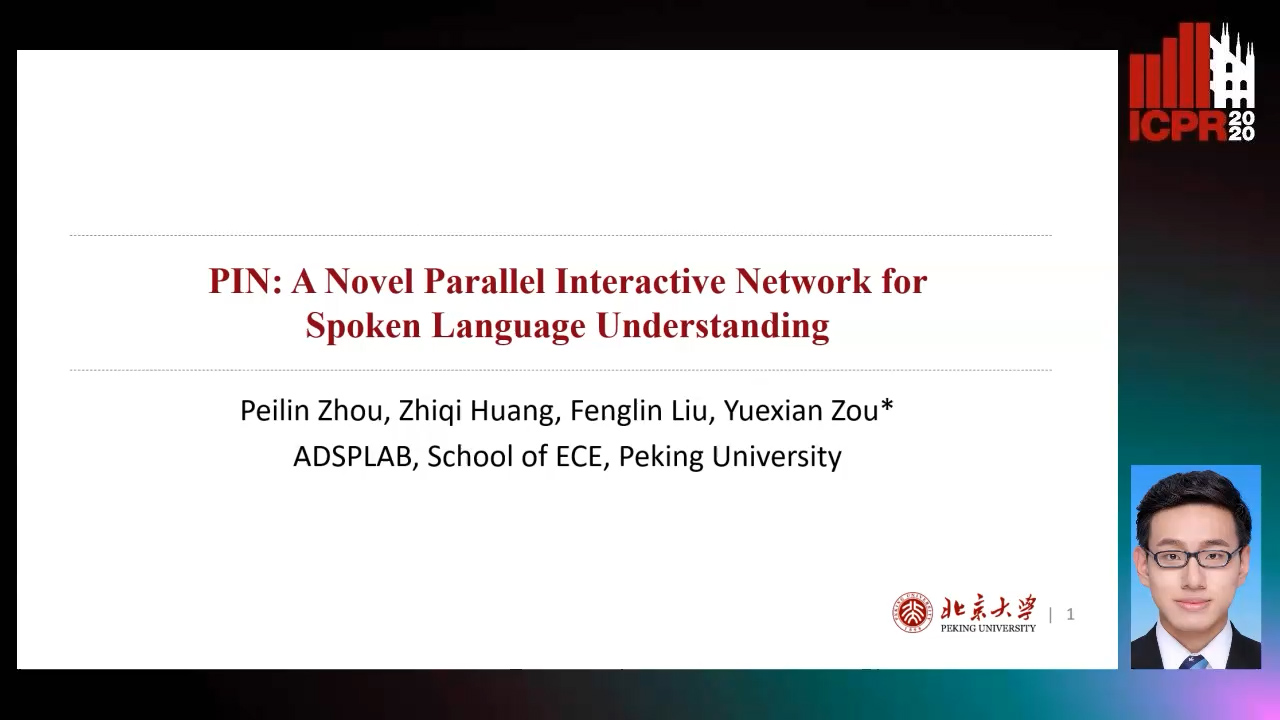
Auto-TLDR; Parallel Interactive Network for Spoken Language Understanding
Abstract Slides Poster Similar
Evaluation of BERT and ALBERT Sentence Embedding Performance on Downstream NLP Tasks
Hyunjin Choi, Judong Kim, Seongho Joe, Youngjune Gwon

Auto-TLDR; Sentence Embedding Models for BERT and ALBERT: A Comparison and Evaluation
Abstract Slides Poster Similar
Automatic Annotation of Corpora for Emotion Recognition through Facial Expressions Analysis
Alex Mircoli, Claudia Diamantini, Domenico Potena, Emanuele Storti
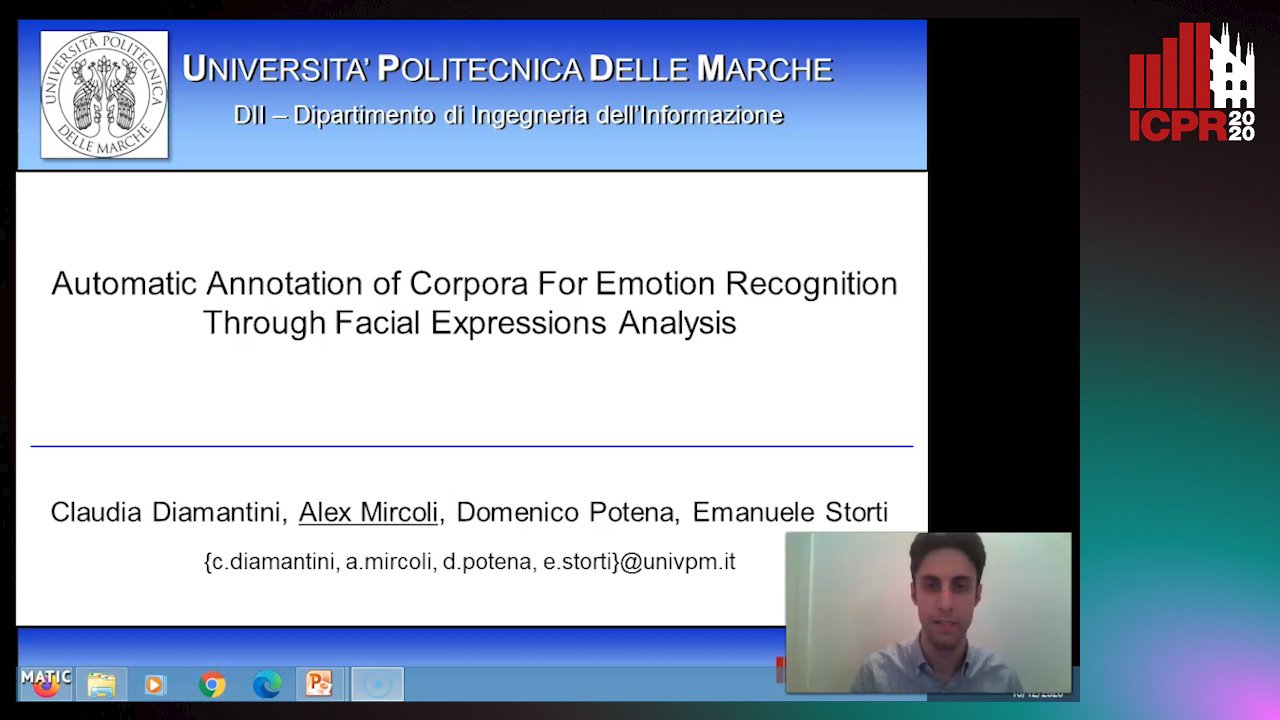
Auto-TLDR; Automatic annotation of video subtitles on the basis of facial expressions using machine learning algorithms
Abstract Slides Poster Similar
Scientific Document Summarization using Citation Context and Multi-objective Optimization
Naveen Saini, Sushil Kumar, Sriparna Saha, Pushpak Bhattacharyya
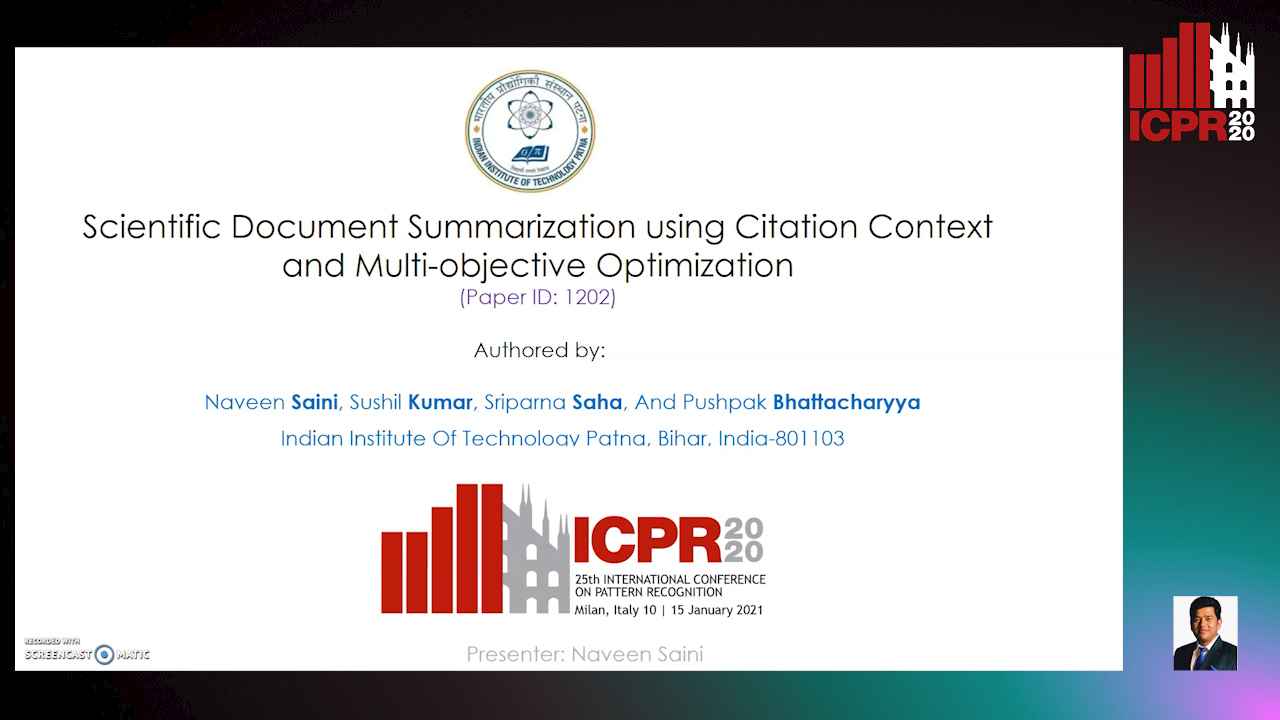
Auto-TLDR; SciSumm Summarization using Multi-Objective Optimization
Abstract Slides Poster Similar
Sequential Domain Adaptation through Elastic Weight Consolidation for Sentiment Analysis
Avinash Madasu, Anvesh Rao Vijjini
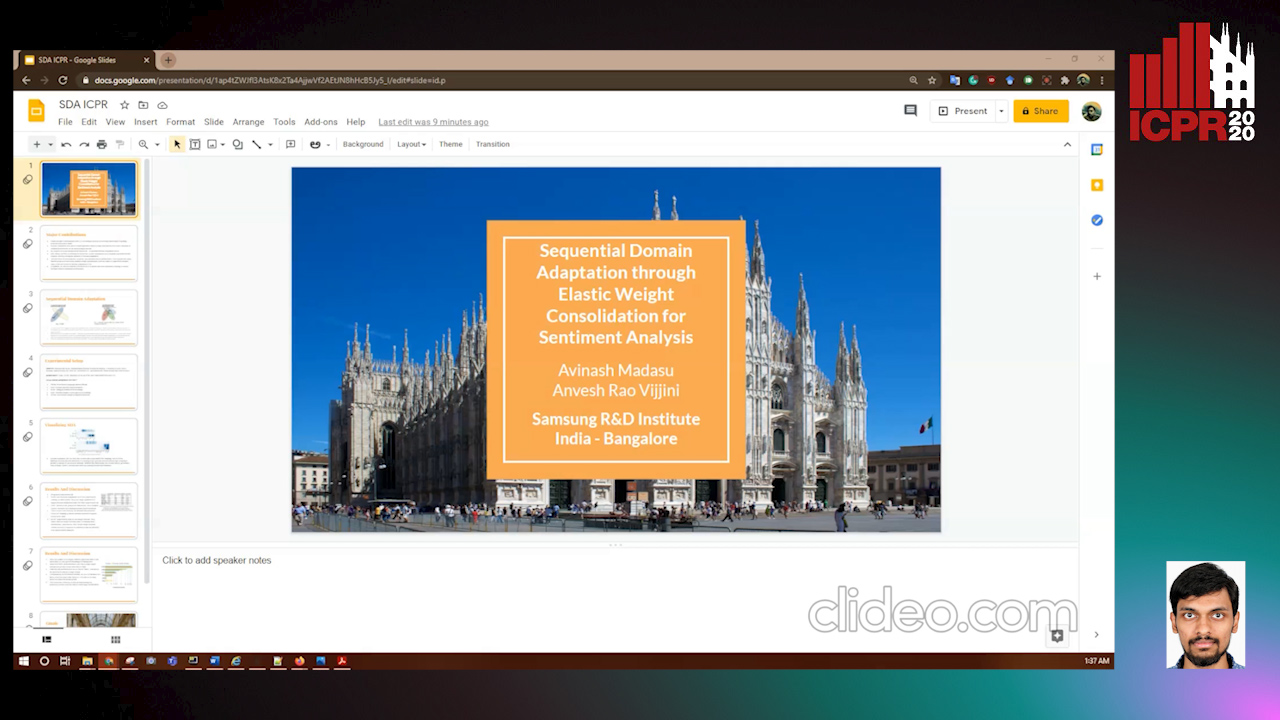
Auto-TLDR; Sequential Domain Adaptation using Elastic Weight Consolidation for Sentiment Analysis
Abstract Slides Poster Similar
Text Synopsis Generation for Egocentric Videos
Aidean Sharghi, Niels Lobo, Mubarak Shah
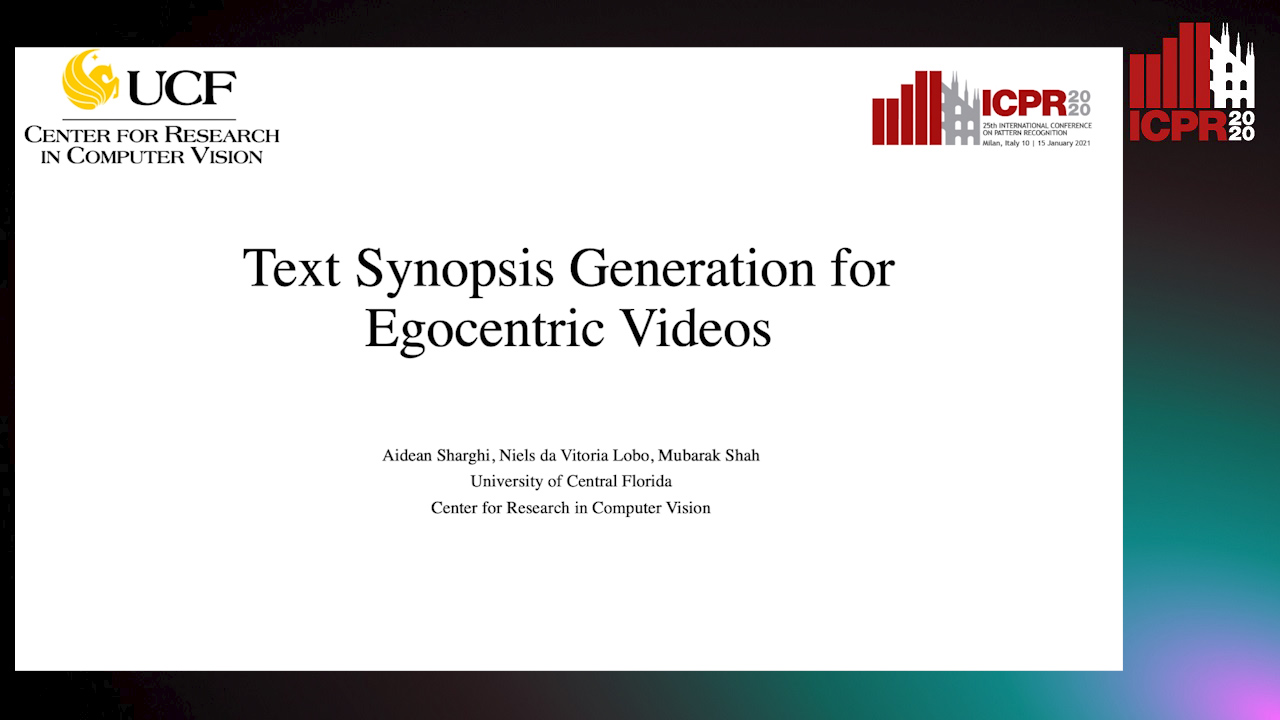
Auto-TLDR; Egocentric Video Summarization Using Multi-task Learning for End-to-End Learning
GCNs-Based Context-Aware Short Text Similarity Model
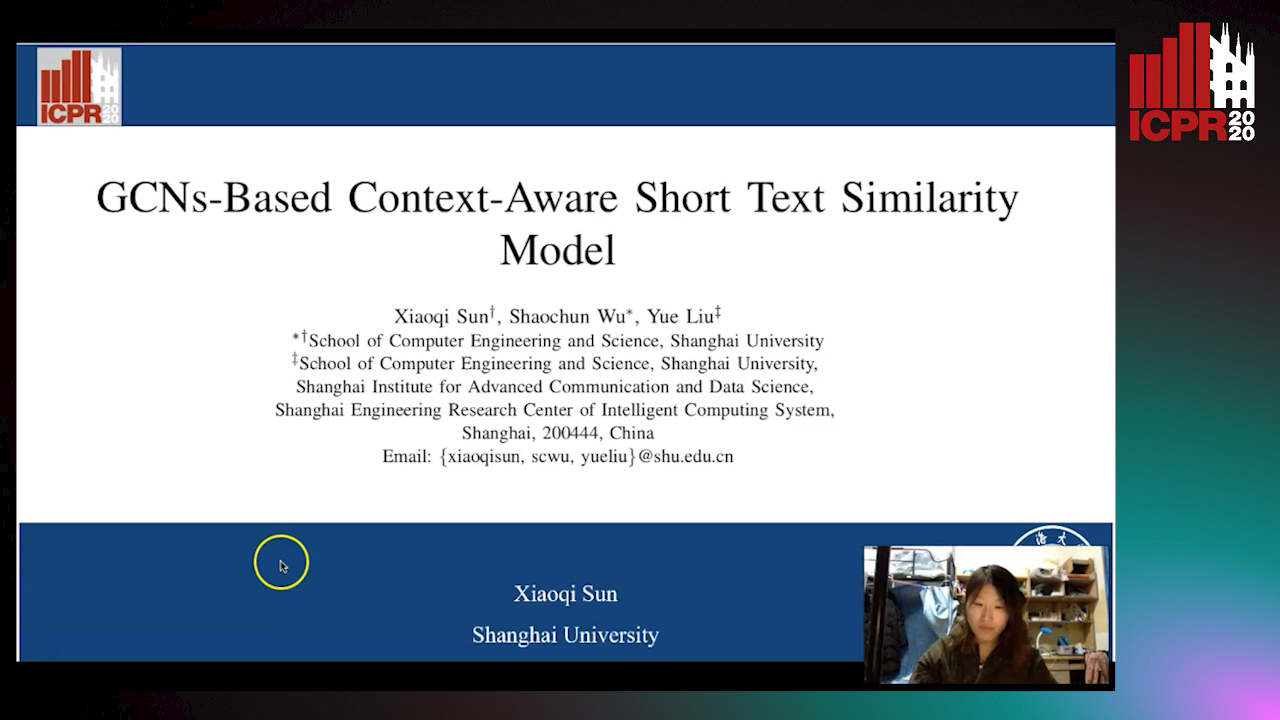
Auto-TLDR; Context-Aware Graph Convolutional Network for Text Similarity
Abstract Slides Poster Similar
Tackling Contradiction Detection in German Using Machine Translation and End-To-End Recurrent Neural Networks
Maren Pielka, Rafet Sifa, Lars Patrick Hillebrand, David Biesner, Rajkumar Ramamurthy, Anna Ladi, Christian Bauckhage
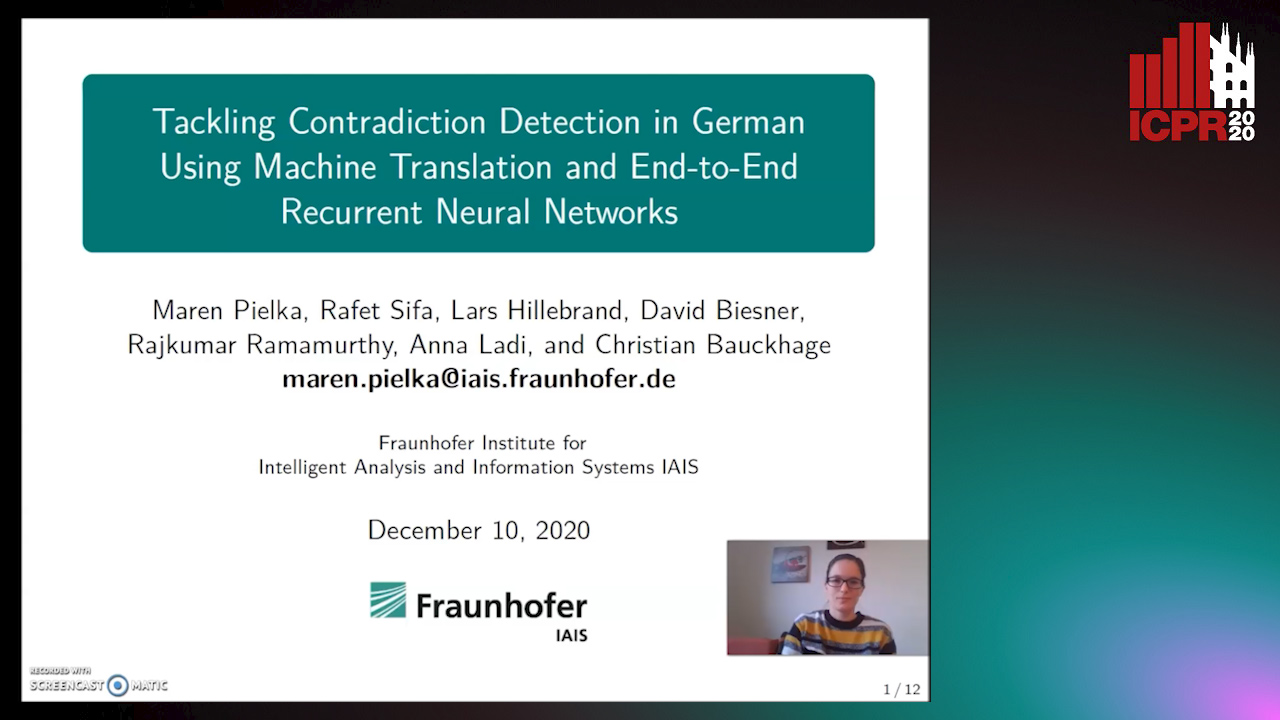
Auto-TLDR; Contradiction Detection in Natural Language Inference using Recurrent Neural Networks
Abstract Slides Poster Similar
Zero-Shot Text Classification with Semantically Extended Graph Convolutional Network
Tengfei Liu, Yongli Hu, Junbin Gao, Yanfeng Sun, Baocai Yin
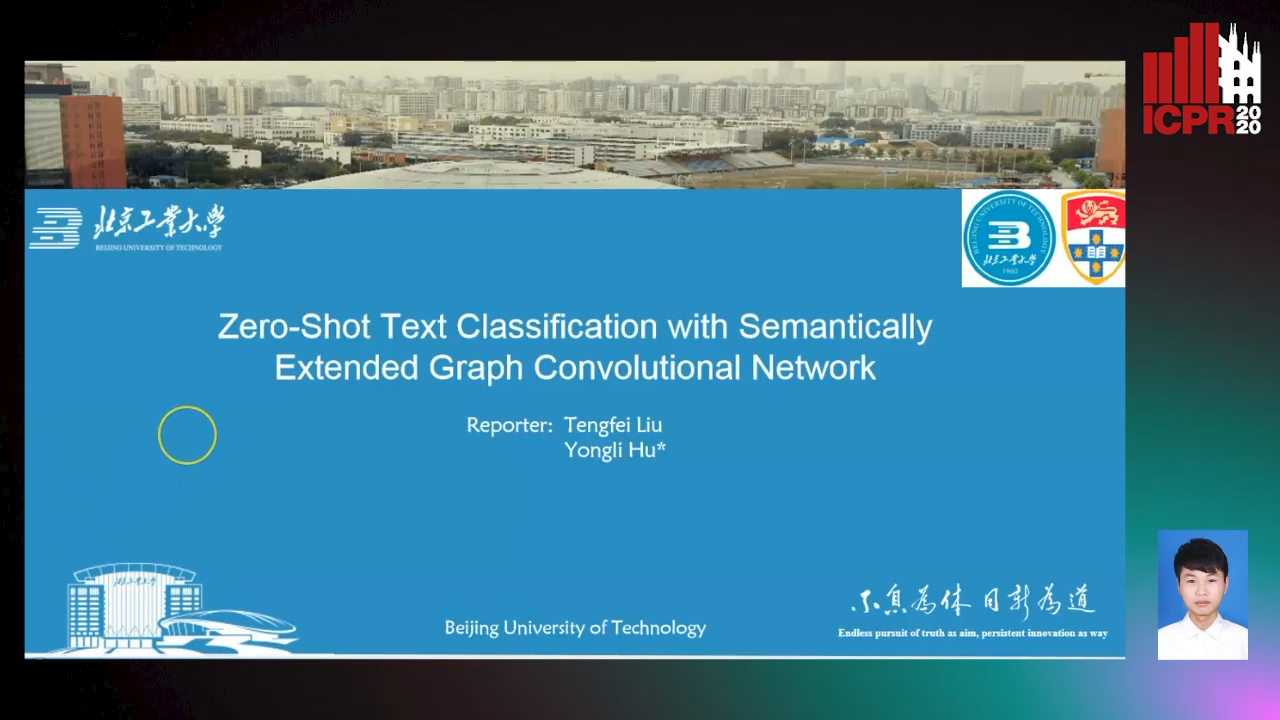
Auto-TLDR; Semantically Extended Graph Convolutional Network for Zero-shot Text Classification
Abstract Slides Poster Similar
Learning Neural Textual Representations for Citation Recommendation
Thanh Binh Kieu, Inigo Jauregi Unanue, Son Bao Pham, Xuan-Hieu Phan, M. Piccardi

Auto-TLDR; Sentence-BERT cascaded with Siamese and triplet networks for citation recommendation
Abstract Slides Poster Similar
Label Incorporated Graph Neural Networks for Text Classification
Yuan Xin, Linli Xu, Junliang Guo, Jiquan Li, Xin Sheng, Yuanyuan Zhou
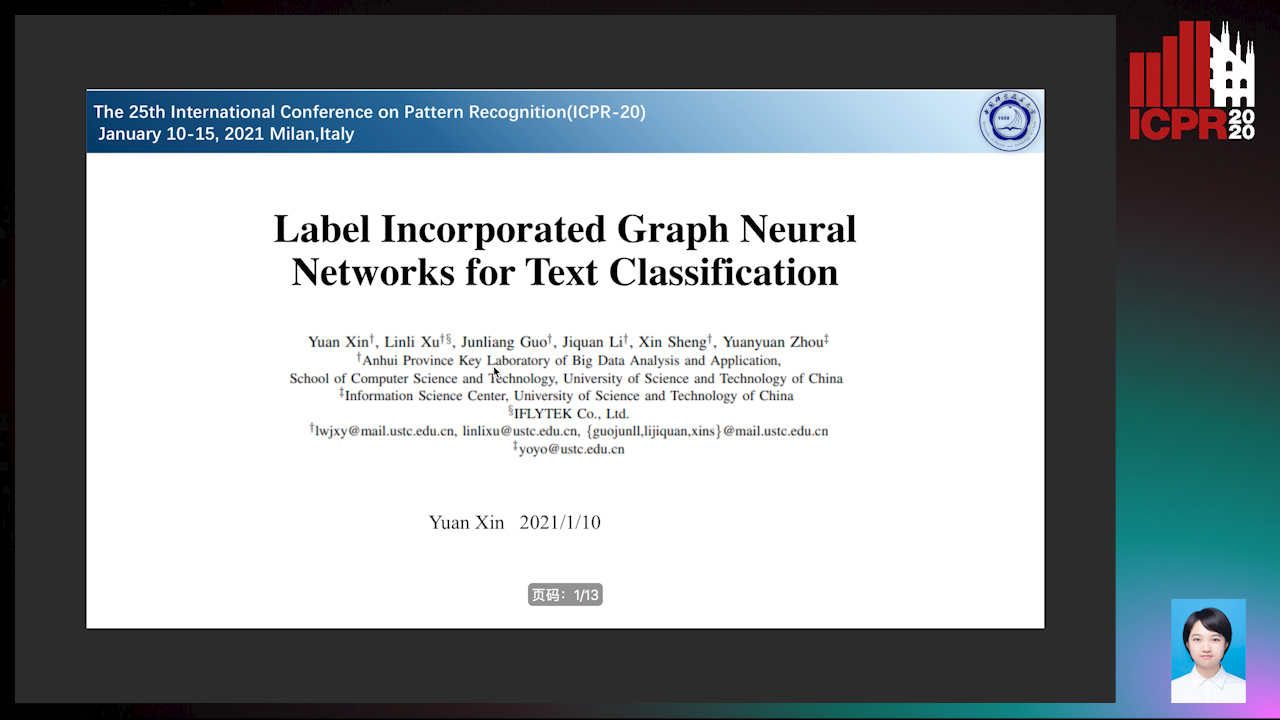
Auto-TLDR; Graph Neural Networks for Semi-supervised Text Classification
Abstract Slides Poster Similar
Explain2Attack: Text Adversarial Attacks via Cross-Domain Interpretability
Mahmoud Hossam, Le Trung, He Zhao, Dinh Phung
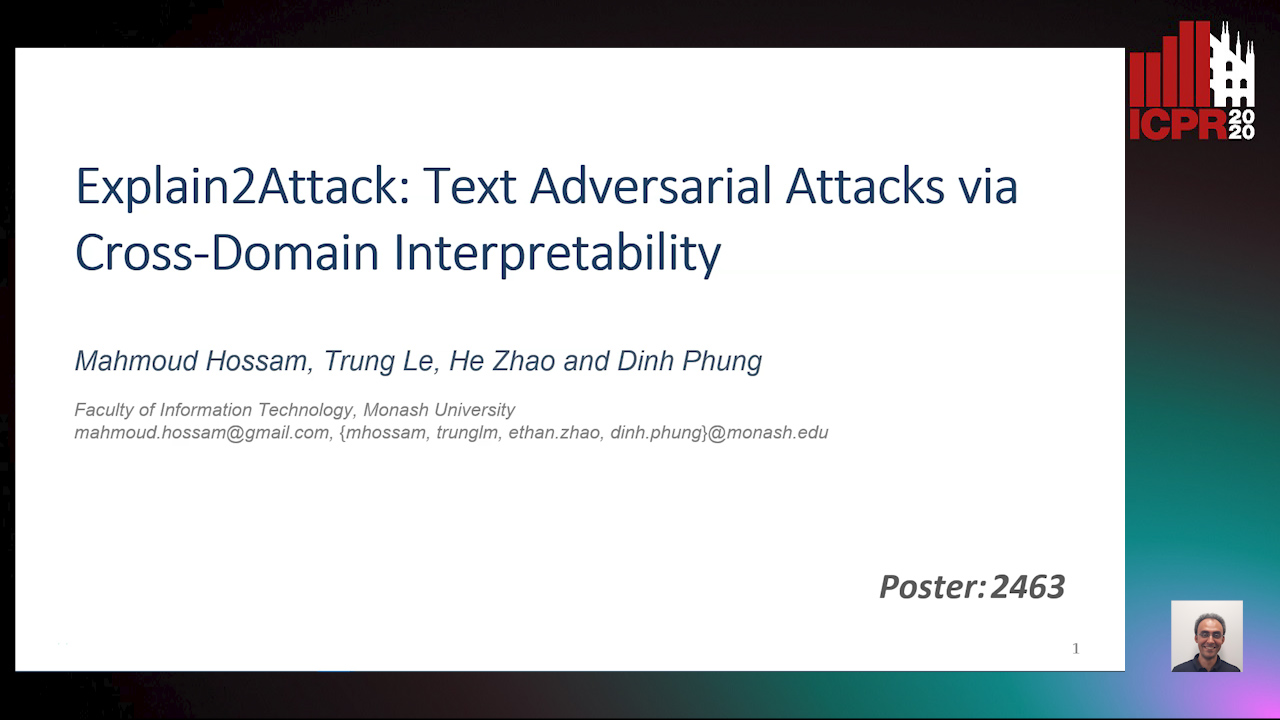
Auto-TLDR; Transfer2Attack: A Black-box Adversarial Attack on Text Classification
Abstract Slides Poster Similar
To Honor Our Heroes: Analysis of the Obituaries of Australians Killed in Action in WWI and WWII

Auto-TLDR; Obituaries of World War I and World War II: A Map of Values and Virtues attributed to Australian Military Personnel
Abstract Slides Poster Similar
PICK: Processing Key Information Extraction from Documents Using Improved Graph Learning-Convolutional Networks
Wenwen Yu, Ning Lu, Xianbiao Qi, Ping Gong, Rong Xiao
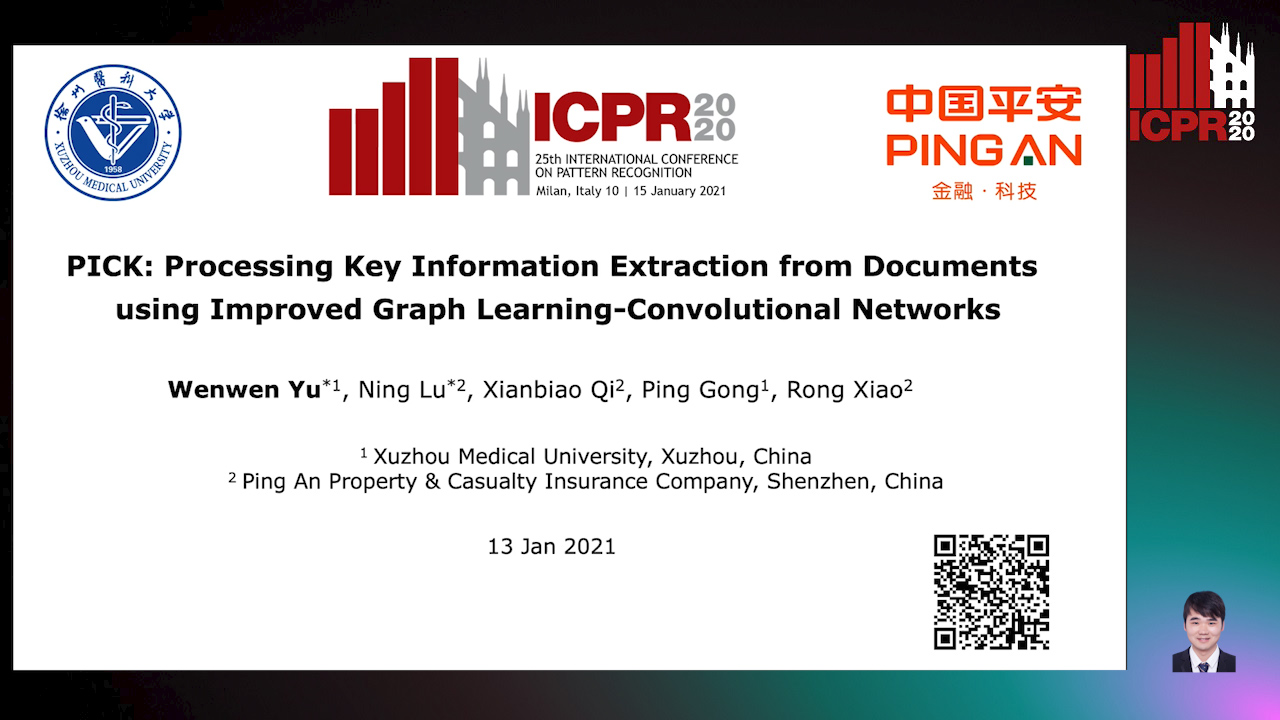
Auto-TLDR; PICK: A Graph Learning Framework for Key Information Extraction from Documents
Abstract Slides Poster Similar
Multi-Modal Identification of State-Sponsored Propaganda on Social Media
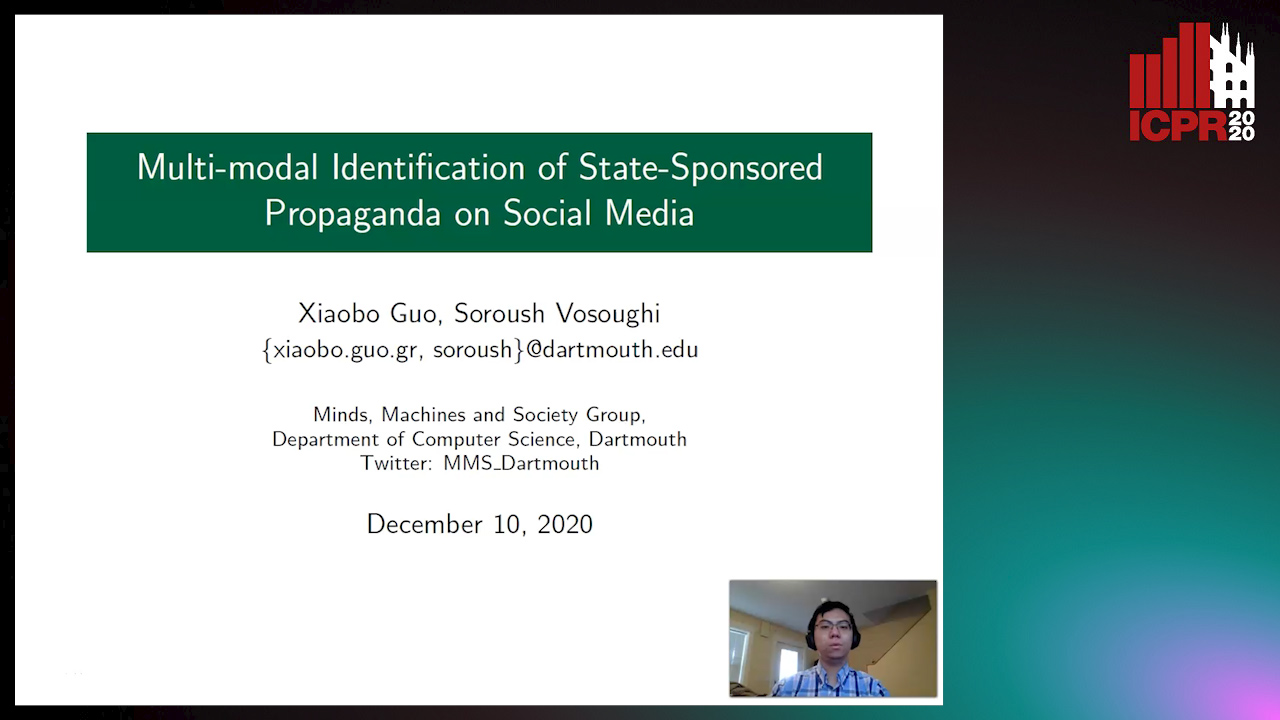
Auto-TLDR; A balanced dataset for detecting state-sponsored Internet propaganda
Abstract Slides Poster Similar
Automatic Classification of Human Granulosa Cells in Assisted Reproductive Technology Using Vibrational Spectroscopy Imaging
Marina Paolanti, Emanuele Frontoni, Giorgia Gioacchini, Giorgini Elisabetta, Notarstefano Valentina, Zacà Carlotta, Carnevali Oliana, Andrea Borini, Marco Mameli
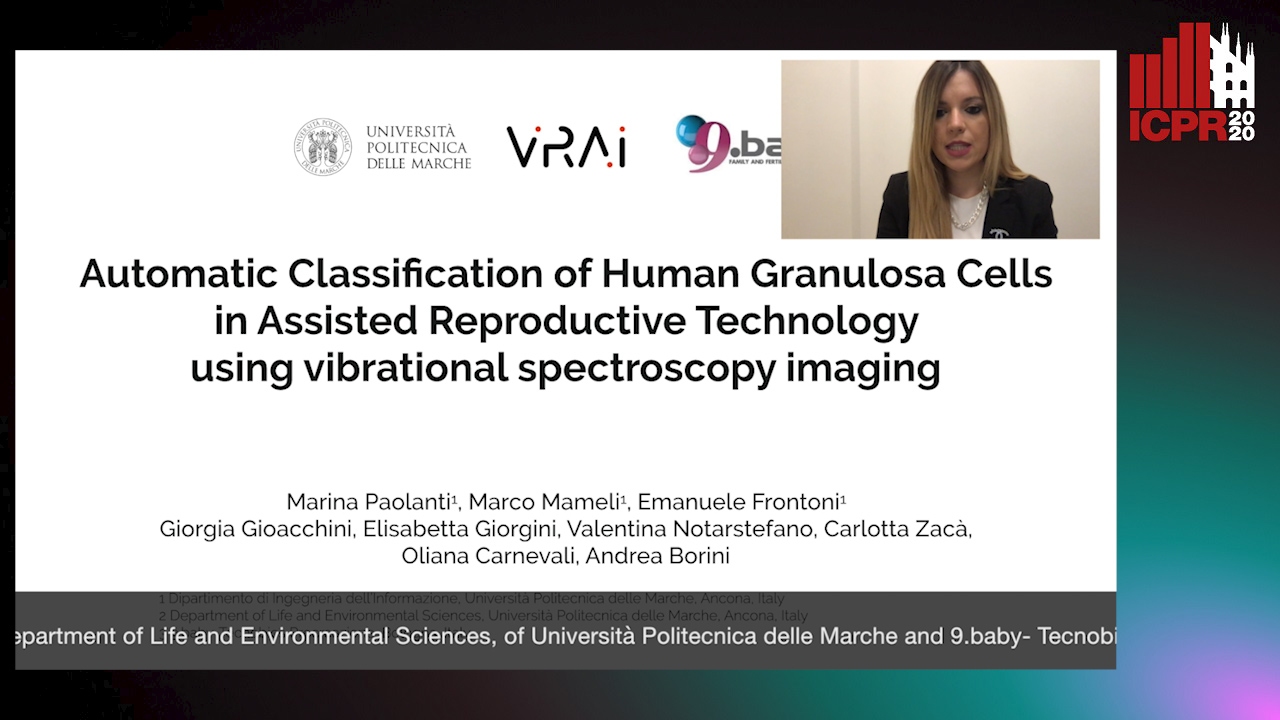
Auto-TLDR; Predicting Oocyte Quality in Assisted Reproductive Technology Using Machine Learning Techniques
Abstract Slides Poster Similar
Attentive Visual Semantic Specialized Network for Video Captioning
Jesus Perez-Martin, Benjamin Bustos, Jorge Pérez
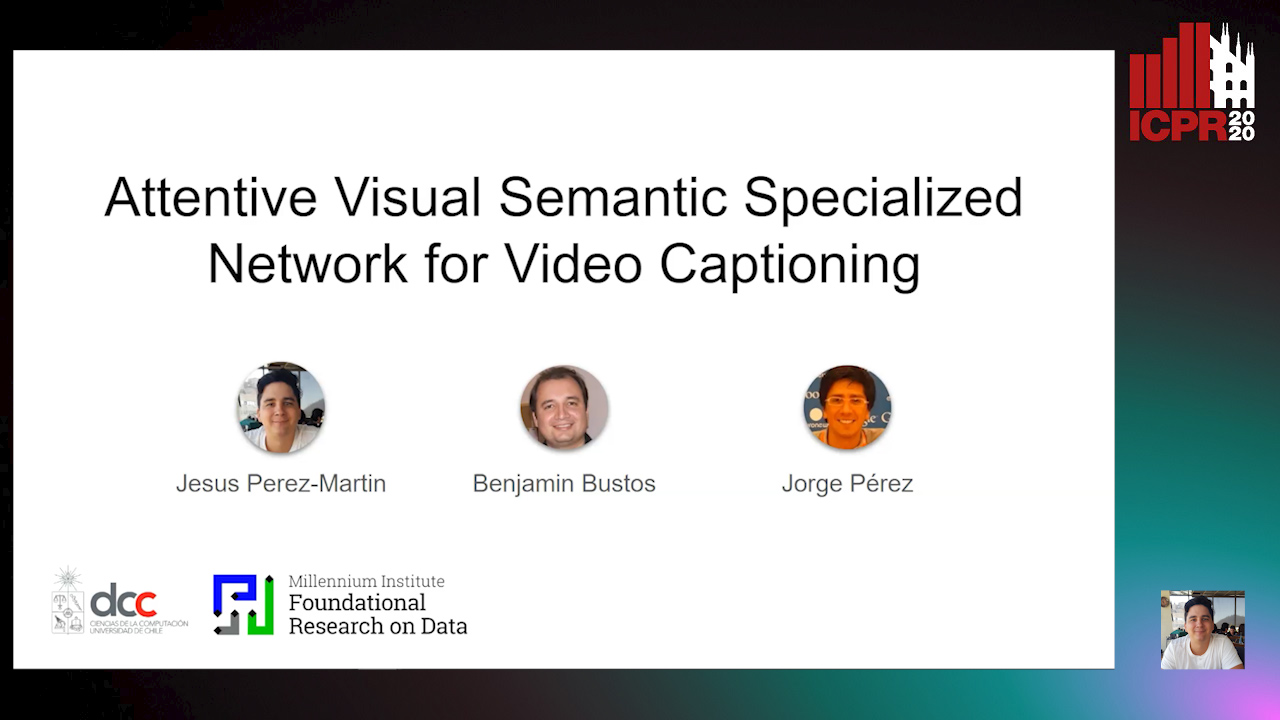
Auto-TLDR; Adaptive Visual Semantic Specialized Network for Video Captioning
Abstract Slides Poster Similar
Analyzing Zero-Shot Cross-Lingual Transfer in Supervised NLP Tasks
Hyunjin Choi, Judong Kim, Seongho Joe, Seungjai Min, Youngjune Gwon

Auto-TLDR; Cross-Lingual Language Model Pretraining for Zero-Shot Cross-lingual Transfer
Abstract Slides Poster Similar
Reinforcement Learning with Dual Attention Guided Graph Convolution for Relation Extraction
Zhixin Li, Yaru Sun, Suqin Tang, Canlong Zhang, Huifang Ma

Auto-TLDR; Dual Attention Graph Convolutional Network for Relation Extraction
Abstract Slides Poster Similar
Enriching Video Captions with Contextual Text
Philipp Rimle, Pelin Dogan, Markus Gross

Auto-TLDR; Contextualized Video Captioning Using Contextual Text
Abstract Slides Poster Similar
Segmenting Messy Text: Detecting Boundaries in Text Derived from Historical Newspaper Images

Auto-TLDR; Text Segmentation of Marriage Announcements Using Deep Learning-based Models
Abstract Slides Poster Similar
End-To-End Triplet Loss Based Emotion Embedding System for Speech Emotion Recognition
Puneet Kumar, Sidharth Jain, Balasubramanian Raman, Partha Pratim Roy, Masakazu Iwamura
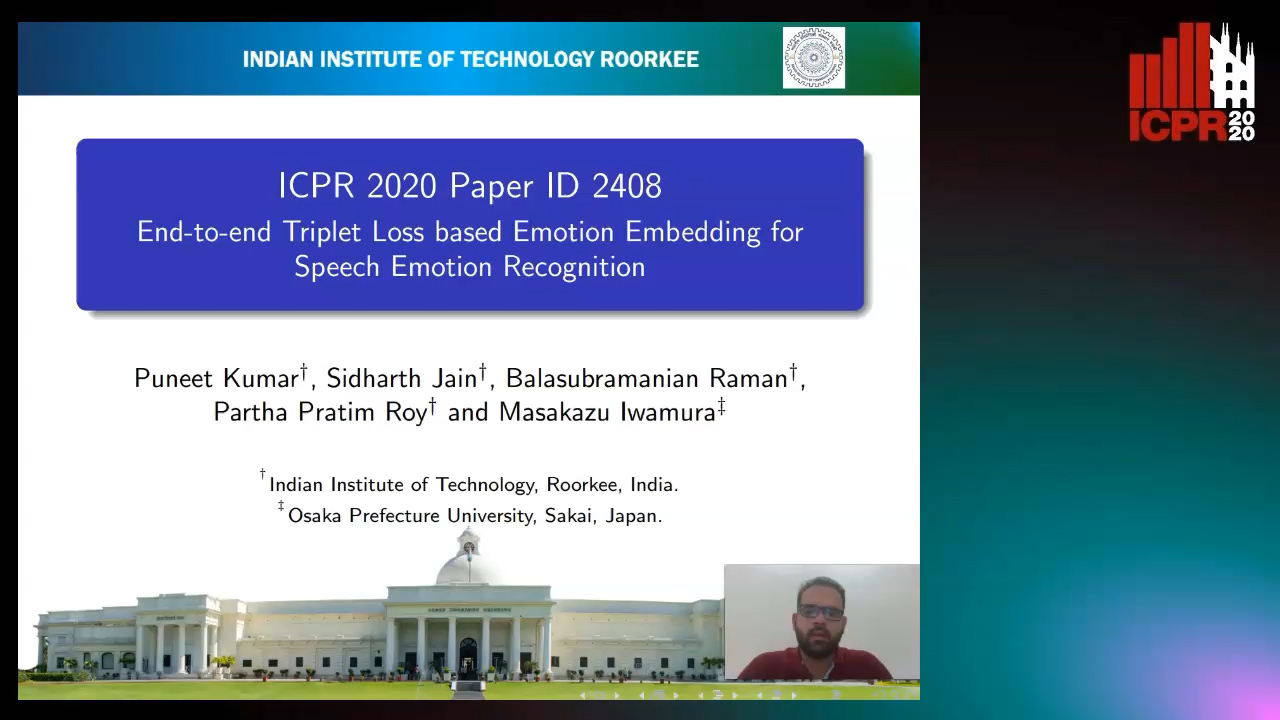
Auto-TLDR; End-to-End Neural Embedding System for Speech Emotion Recognition
Abstract Slides Poster Similar
Pose-Based Body Language Recognition for Emotion and Psychiatric Symptom Interpretation
Zhengyuan Yang, Amanda Kay, Yuncheng Li, Wendi Cross, Jiebo Luo

Auto-TLDR; Body Language Based Emotion Recognition for Psychiatric Symptoms Prediction
Abstract Slides Poster Similar
Dual Path Multi-Modal High-Order Features for Textual Content Based Visual Question Answering
Yanan Li, Yuetan Lin, Hongrui Zhao, Donghui Wang

Auto-TLDR; TextVQA: An End-to-End Visual Question Answering Model for Text-Based VQA
Leveraging Sequential Pattern Information for Active Learning from Sequential Data
Raul Fidalgo-Merino, Lorenzo Gabrielli, Enrico Checchi
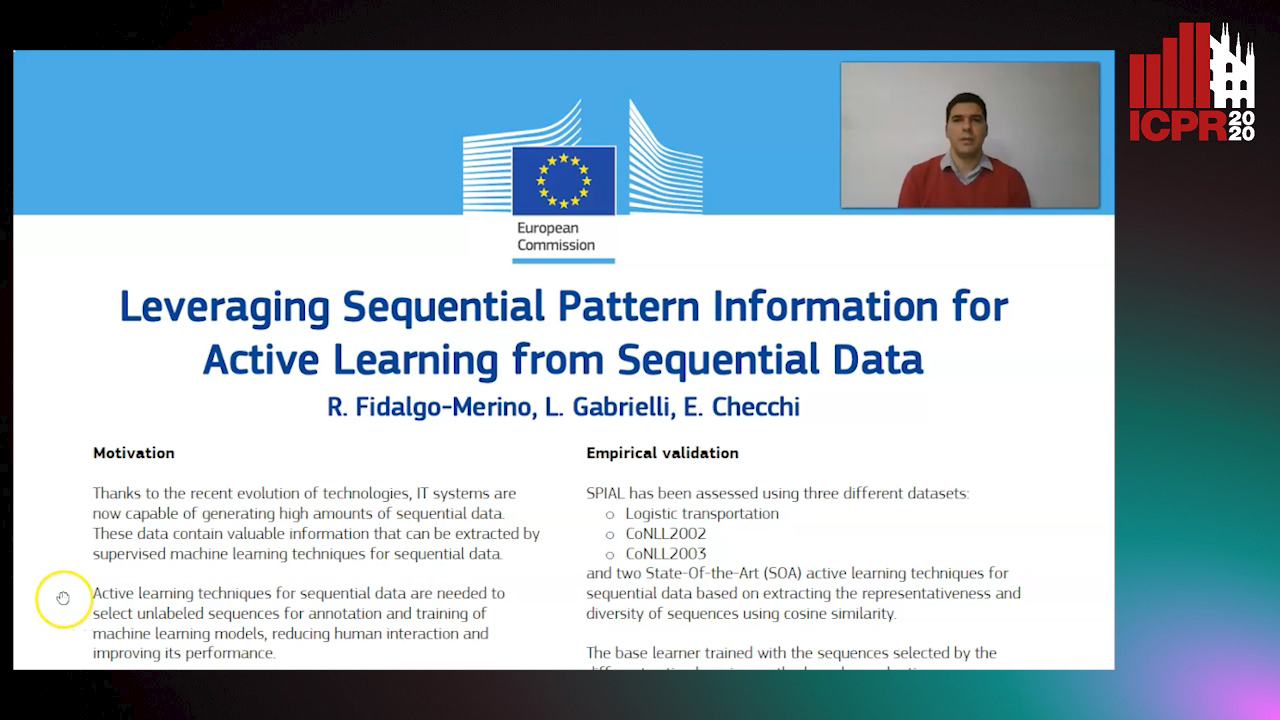
Auto-TLDR; Sequential Pattern Information for Active Learning
Abstract Slides Poster Similar
Automatic Student Network Search for Knowledge Distillation
Zhexi Zhang, Wei Zhu, Junchi Yan, Peng Gao, Guotong Xie
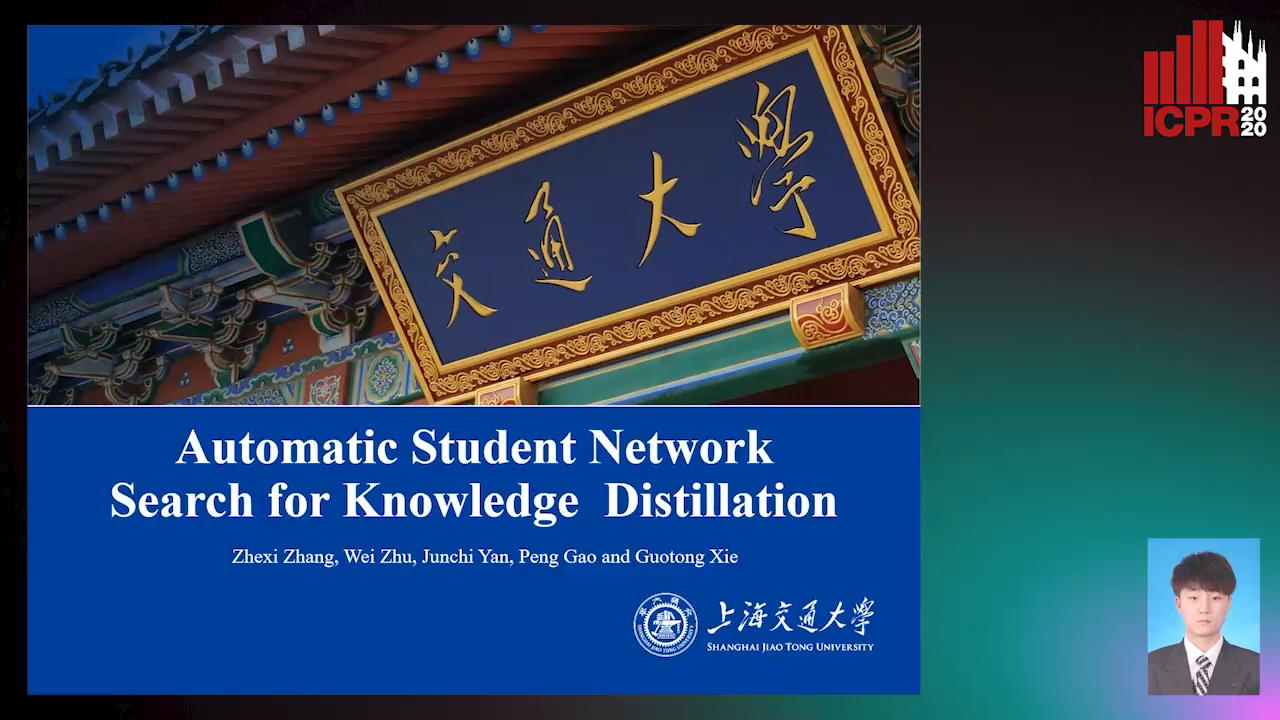
Auto-TLDR; NAS-KD: Knowledge Distillation for BERT
Abstract Slides Poster Similar
Information Graphic Summarization Using a Collection of Multimodal Deep Neural Networks
Edward Kim, Connor Onweller, Kathleen F. Mccoy

Auto-TLDR; A multimodal deep learning framework that can generate summarization text supporting the main idea of an information graphic for presentation to blind or visually impaired
Transformer Networks for Trajectory Forecasting
Francesco Giuliari, Hasan Irtiza, Marco Cristani, Fabio Galasso

Auto-TLDR; TransformerNetworks for Trajectory Prediction of People Interactions
Abstract Slides Poster Similar
Multimodal Side-Tuning for Document Classification
Stefano Zingaro, Giuseppe Lisanti, Maurizio Gabbrielli

Auto-TLDR; Side-tuning for Multimodal Document Classification
Abstract Slides Poster Similar
Classifying Eye-Tracking Data Using Saliency Maps
Shafin Rahman, Sejuti Rahman, Omar Shahid, Md. Tahmeed Abdullah, Jubair Ahmed Sourov

Auto-TLDR; Saliency-based Feature Extraction for Automatic Classification of Eye-tracking Data
Abstract Slides Poster Similar
CKG: Dynamic Representation Based on Context and Knowledge Graph
Xunzhu Tang, Tiezhu Sun, Rujie Zhu

Auto-TLDR; CKG: Dynamic Representation Based on Knowledge Graph for Language Sentences
Abstract Slides Poster Similar
Trajectory-User Link with Attention Recurrent Networks
Tao Sun, Yongjun Xu, Fei Wang, Lin Wu, 塘文 钱, Zezhi Shao
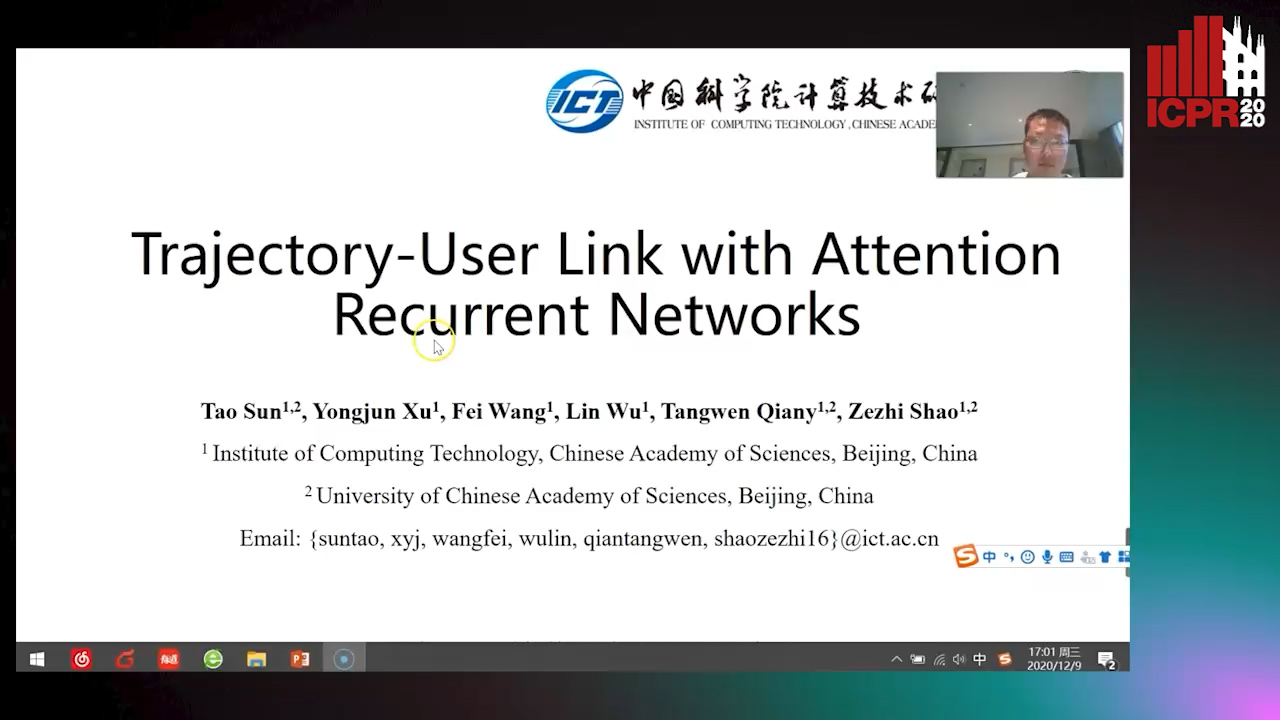
Auto-TLDR; TULAR: Trajectory-User Link with Attention Recurrent Neural Networks
Abstract Slides Poster Similar
Cross-Lingual Text Image Recognition Via Multi-Task Sequence to Sequence Learning
Zhuo Chen, Fei Yin, Xu-Yao Zhang, Qing Yang, Cheng-Lin Liu

Auto-TLDR; Cross-Lingual Text Image Recognition with Multi-task Learning
Abstract Slides Poster Similar
A Multi-Task Multi-View Based Multi-Objective Clustering Algorithm
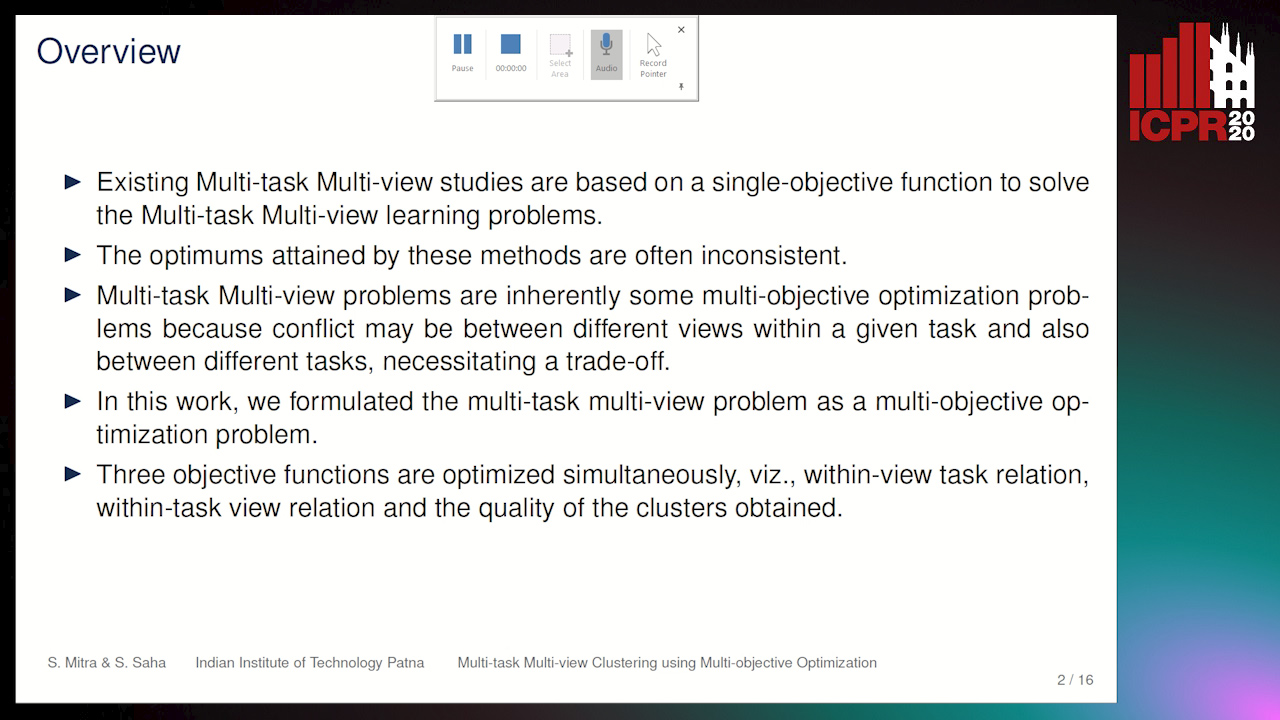
Auto-TLDR; MTMV-MO: Multi-task multi-view multi-objective optimization for multi-task clustering
Abstract Slides Poster Similar
Moto: Enhancing Embedding with Multiple Joint Factors for Chinese Text Classification
Xunzhu Tang, Rujie Zhu, Tiezhu Sun

Auto-TLDR; Moto: Enhancing Embedding with Multiple J\textbf{o}int Fac\textBF{to}rs
Abstract Slides Poster Similar
Cross-Supervised Joint-Event-Extraction with Heterogeneous Information Networks
Yue Wang, Zhuo Xu, Yao Wan, Lu Bai, Lixin Cui, Qian Zhao, Edwin Hancock, Philip Yu
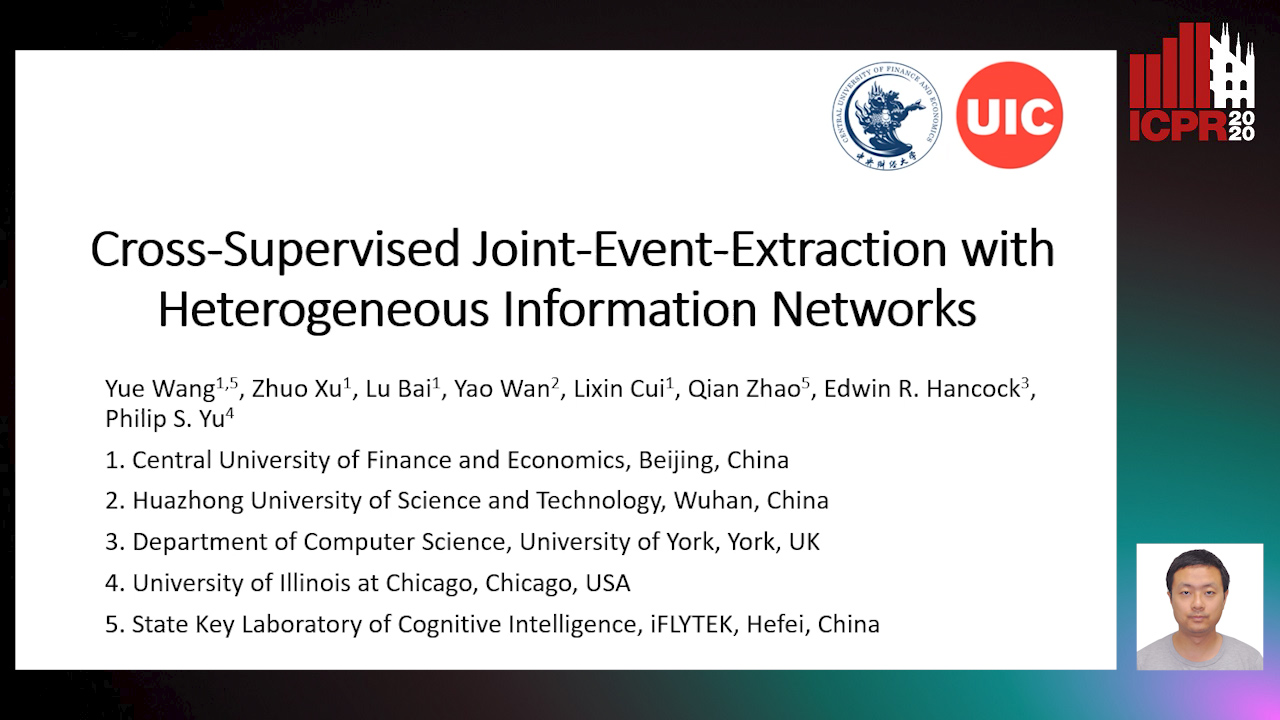
Auto-TLDR; Joint-Event-extraction from Unstructured corpora using Structural Information Network
Abstract Slides Poster Similar
Textual-Content Based Classification of Bundles of Untranscribed of Manuscript Images
José Ramón Prieto Fontcuberta, Enrique Vidal, Vicente Bosch, Carlos Alonso, Carmen Orcero, Lourdes Márquez

Auto-TLDR; Probabilistic Indexing for Text-based Classification of Manuscripts
Abstract Slides Poster Similar
Emerging Relation Network and Task Embedding for Multi-Task Regression Problems
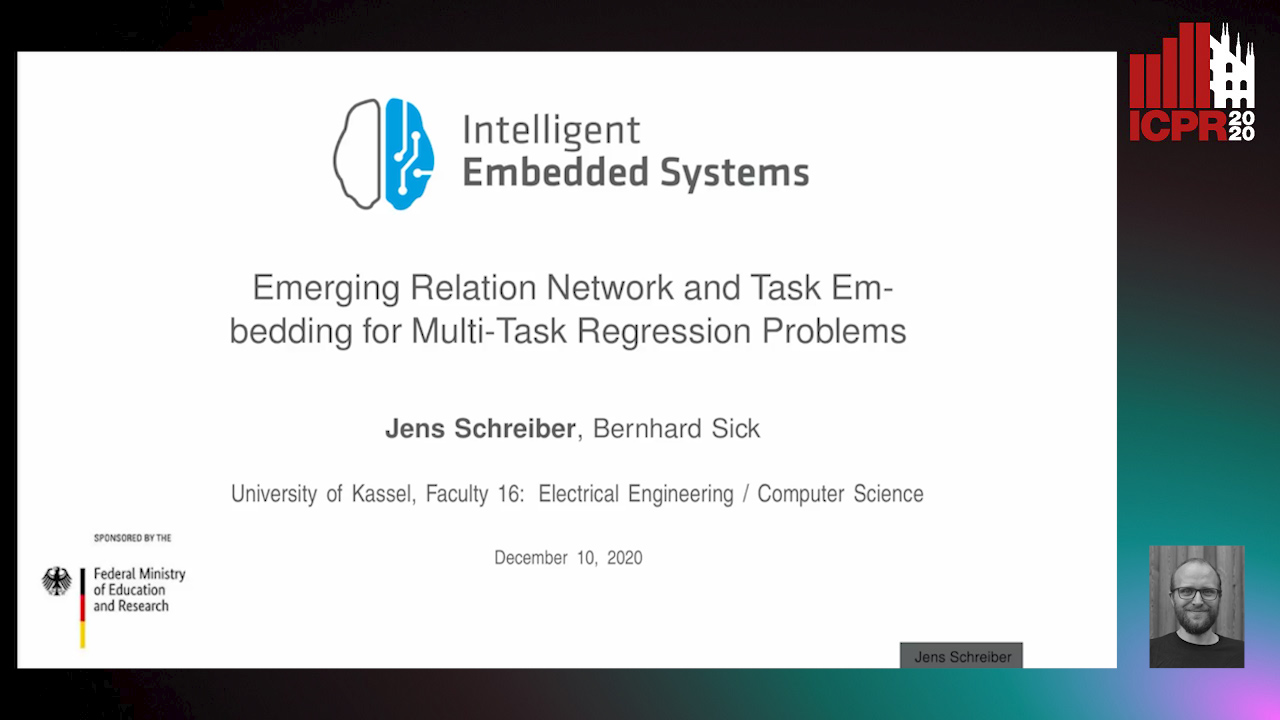
Auto-TLDR; A Comparative Study of Multi-Task Learning for Non-linear Time Series Problems
Abstract Slides Poster Similar
Extracting Action Hierarchies from Action Labels and their Use in Deep Action Recognition
Konstadinos Bacharidis, Antonis Argyros
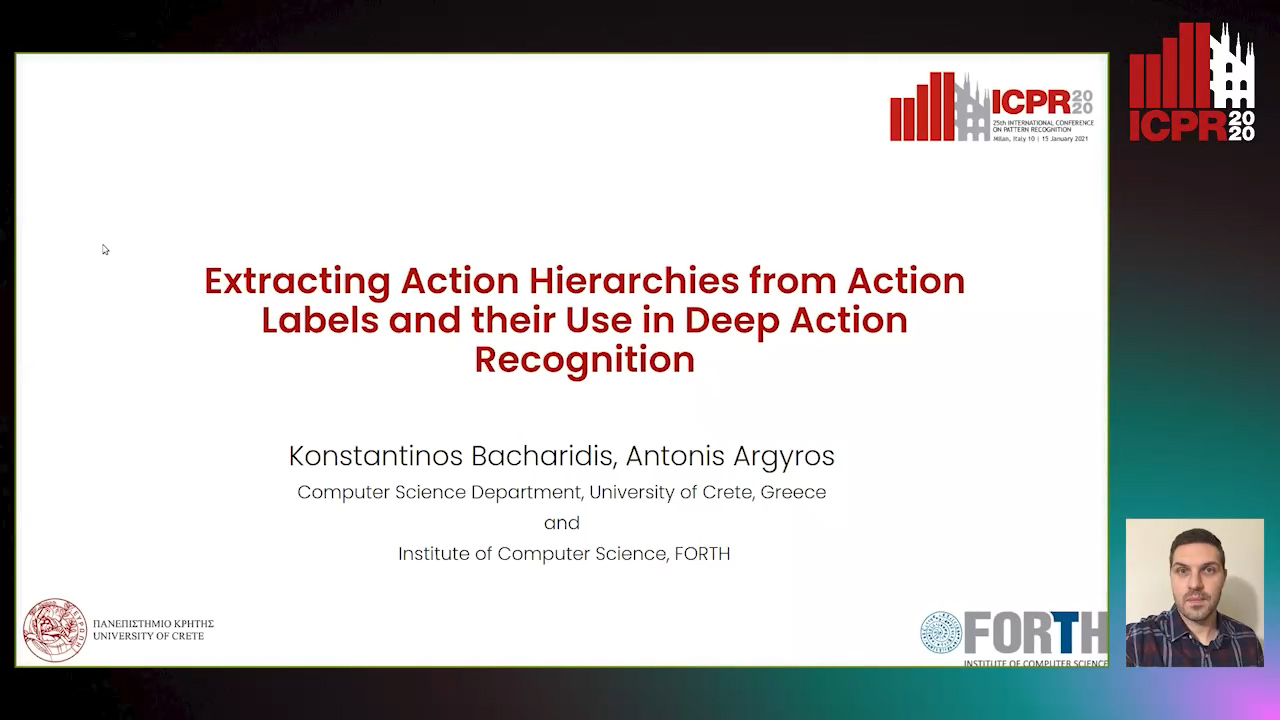
Auto-TLDR; Exploiting the Information Content of Language Label Associations for Human Action Recognition
Abstract Slides Poster Similar
Exploring Spatial-Temporal Representations for fNIRS-based Intimacy Detection via an Attention-enhanced Cascade Convolutional Recurrent Neural Network
Chao Li, Qian Zhang, Ziping Zhao
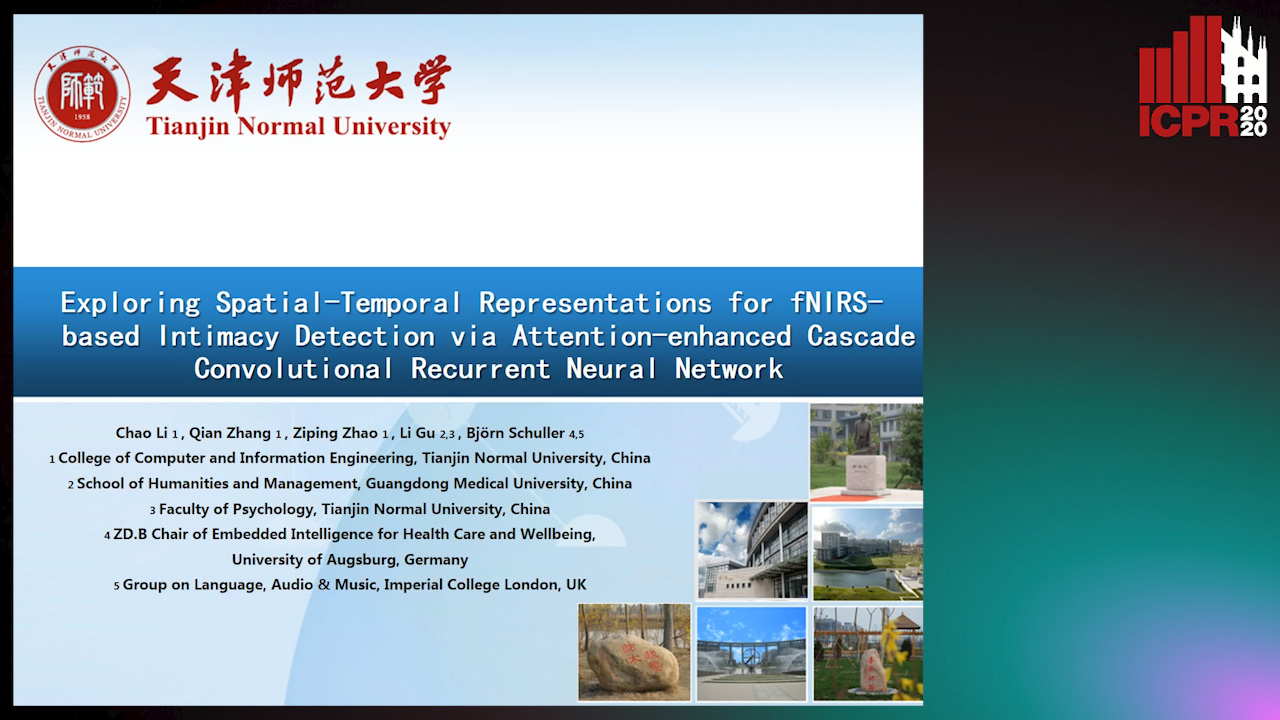
Auto-TLDR; Intimate Relationship Prediction by Attention-enhanced Cascade Convolutional Recurrent Neural Network Using Functional Near-Infrared Spectroscopy
Abstract Slides Poster Similar
PrivAttNet: Predicting Privacy Risks in Images Using Visual Attention
Chen Zhang, Thivya Kandappu, Vigneshwaran Subbaraju

Auto-TLDR; PrivAttNet: A Visual Attention Based Approach for Privacy Sensitivity in Images
Abstract Slides Poster Similar
Learning Emotional Blinded Face Representations
Alejandro Peña Almansa, Julian Fierrez, Agata Lapedriza, Aythami Morales

Auto-TLDR; Blind Face Representations for Emotion Recognition
Abstract Slides Poster Similar
Predicting Chemical Properties Using Self-Attention Multi-Task Learning Based on SMILES Representation
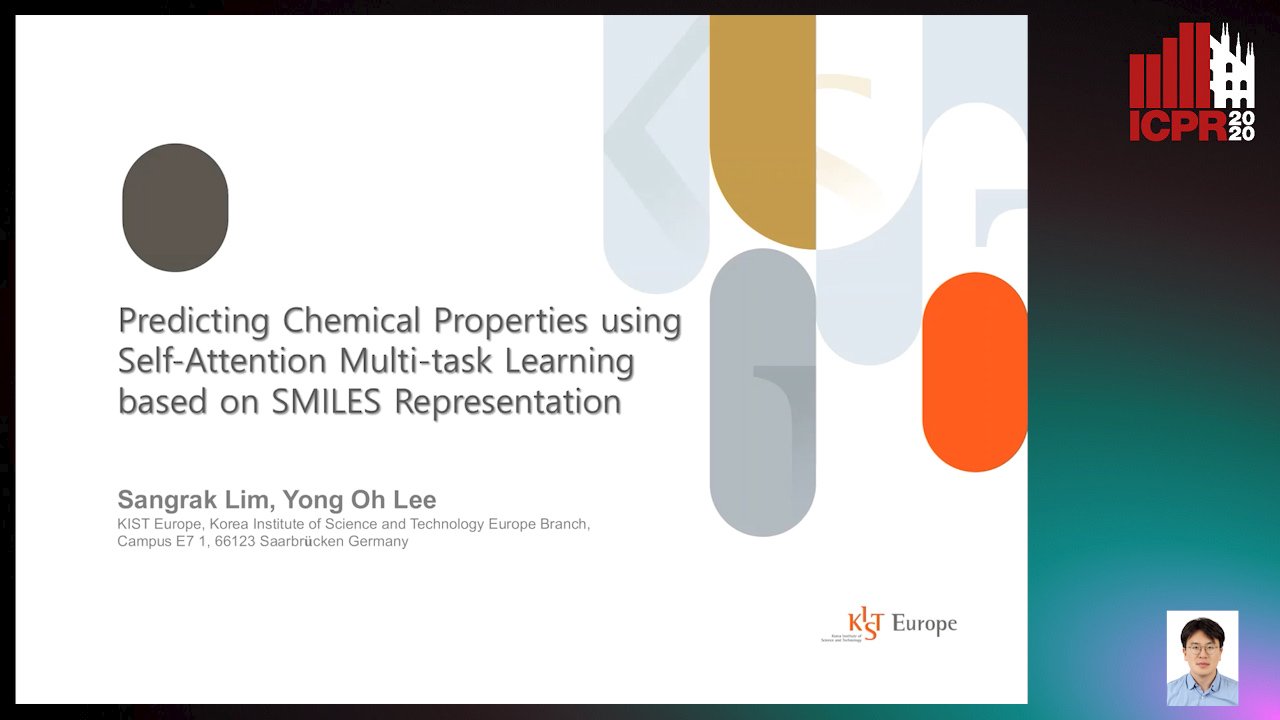
Auto-TLDR; Self-attention based Transformer-Variant Model for Chemical Compound Properties Prediction
Abstract Slides Poster Similar
Deep Learning Based Sepsis Intervention: The Modelling and Prediction of Severe Sepsis Onset
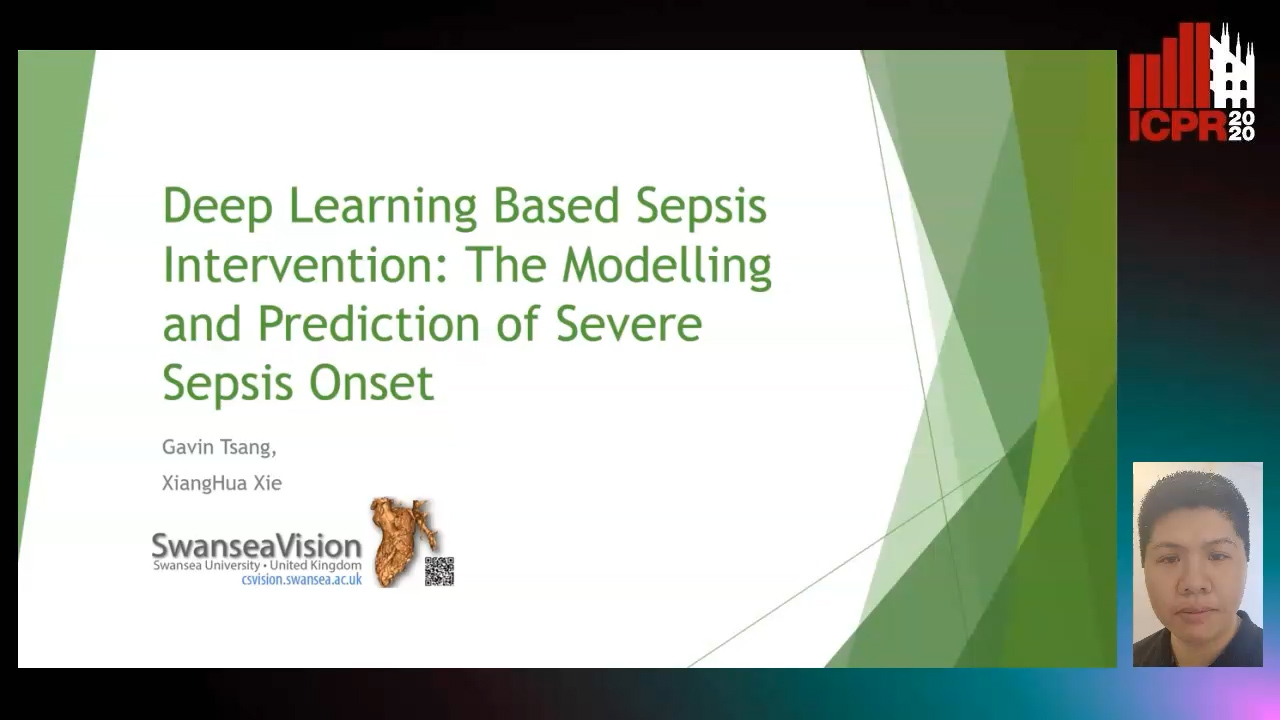
Auto-TLDR; Predicting Sepsis onset by up to six hours prior using a boosted cascading training methodology and adjustable margin hinge loss function
Abstract Slides Poster Similar